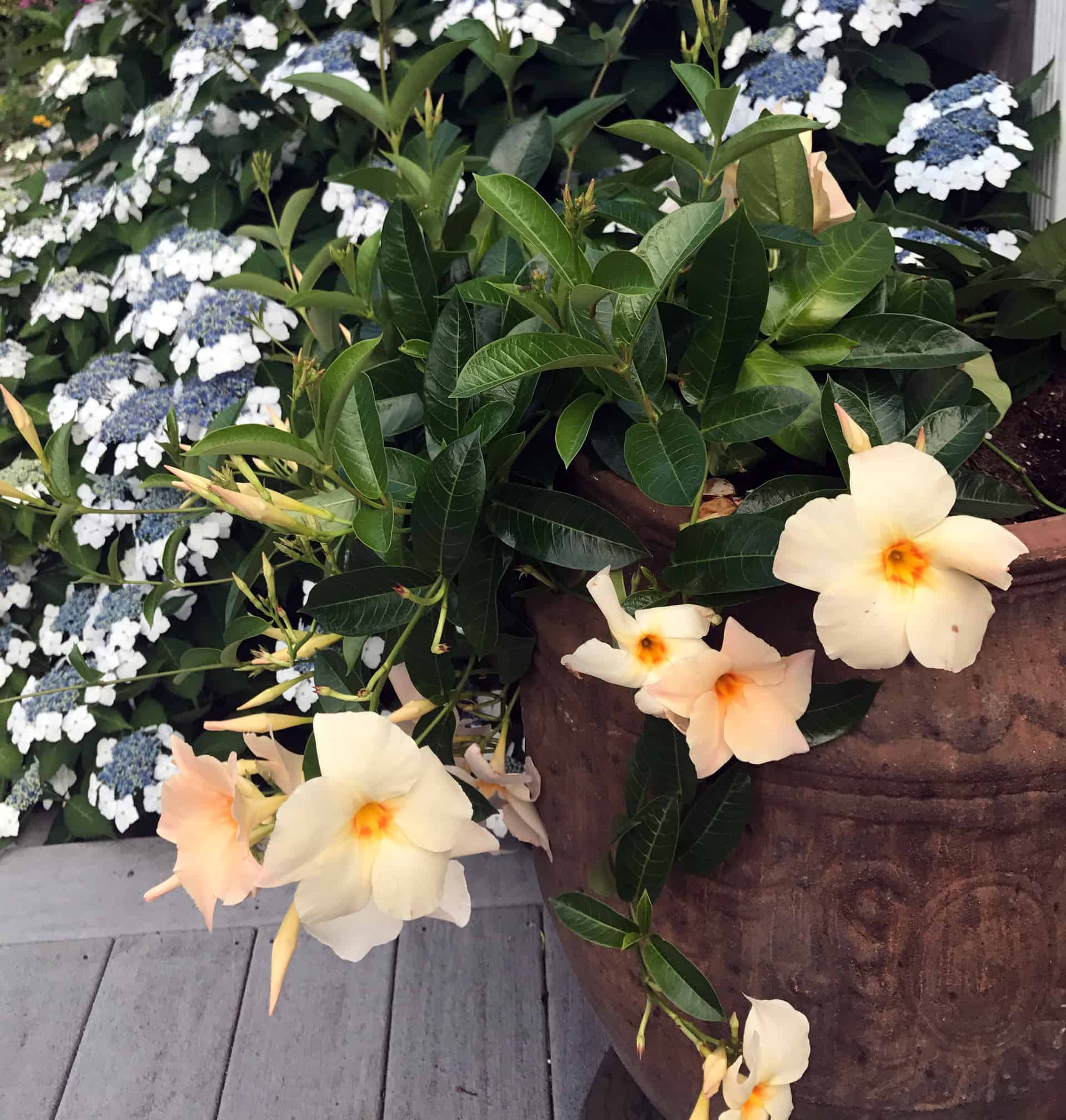Imagine: They wandered through the perennial vines at the garden center, looking at climbing hydrangeas, honeysuckle and wisteria. “These are grow so large,” she said after reading the tags. “And they don’t flower all summer,” he said, after googling the plants’ names. The couple stood in the vine section, looking perplexed.
A garden center employee approached the couple and asked how he could help.
“We want a vine for a small trellis next to our deck,” she said.
“And we’d like something that flowers all summer,” he said.
“Maybe something in bright pink?” she added.
The garden center employee nodded, and motioned them toward the tropical plants. “You want a Mandevilla,” he said with certainty.
And they did.
Name: Mandevilla spp. Aka mandevilla vine
Type of Plant: A tropical vine that many in northern climates grow as an annual. Large, tubular flowers in white, pink, yellow, apricot, or red. Some grow as large vines, and others are more bush-like. All are easy, glorious annuals.
Why I love this: These plants are showy, reliable, and no deadheading. There is a size for every garden, container or structure; some are perfect for hanging baskets, others scramble up obelisks and trellises, and a few are lovely in window boxes and large pots.
A Word to the Wise: When you purchase a Mandevilla vine be sure you’re getting a variety that will grow as large as you want it to. The large vining varieties aren’t suitable for a widow box, for example, and some of the shorter types won’t fill a trellis or arbor. And don’t be confused by the fact that the shorter growing types with shiny leaves are often labeled Diplodenia…this is an old name that is still in circulation. All of these tropical, trumpet-flowering vines are in the genus Mandevilla.
Be sure to grow this plant where it will receive at least five hours of direct sun and fertilize these plants through the summer.

This larger growing Mandevilla has bigger leaves that aren’t very shiny. They can frequently be found already five feet tall, so you can get a jump-start on the summer display. As pictured here, you can combine Mandevilla with other plants in a very large pot.

This particular Mandevilla has shiny leaves and a moderate growth habit.

New colors of Mandevilla are being introduced every year! We can find yellow, apricot, white and many shades of pink in the garden centers every spring and early summer.

Looking for a flowering vine that will bloom all summer? Forget perennial and woody plants…go tropical! Mandevilla vine will delight you all summer long.


Lace cap hydrangea (Light O’day) planted by builder in PineHills, Plymouth. Location gets full morning sun till about 1 PM then late afternoon. Winter gets tunnel effect cold wind between line of homes and dense woods.. Result: buds get burned, turn black and don’t flower. Eleven summers have produced flowers only twice., but always lush variegated foliage. Flowers when they arrive are beautiful. I feed with Hollytone Spring and Fall and water with soaker hose to avoid leaf wilting when necessary.. I cut all the unproductive canes in early summer and am ready to cut back all three bushes by one third. They are now about 3-4 ft tall. I’m too old to dig them up and too cheap to pay someone else to do it. Your suggestions, please. Peonies seed pods: remove after blooming or let them drop and remove in Fall. Ditto Stella D’oro seed pods.. Enjoy your radio show and look forward to your return to Great Island.
George,
If you don’t want to move them, just live with them not flowering. Sorry – the location is one that isn’t suited for this plant. Maybe you could tie silk hydrangea flowers on it? 😉
Cut the peony and daylily seed pods off – including stems on Stella. looks SO much better!